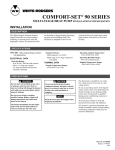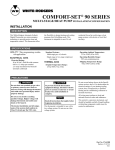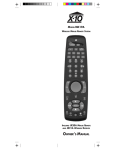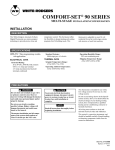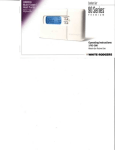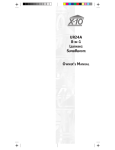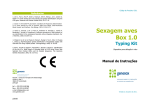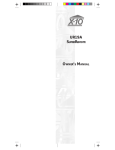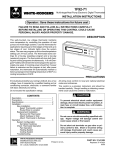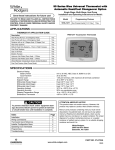Download Emerson 1F92 Heat Pump User Manual
Transcript
Universal Multi-Stage Heat Pump Digital 5/2 Day Programmable 90 Series TM P R E M I U M Oper a ting Instr uctions Opera Instructions 1F92 Retain for Future Use Easy, Menu-Driven Set-Up and Programming 1 2 3 4 5 6 7 8 9 10 11 12 Premium options to customize the thermostat to fit your application. 17 16 15 14 13 INTRODUCTION Thank you for purchasing your new Comfort-Set 90 Series thermostat. Your new White-Rodgers thermostat uses solid state microcomputer technology to provide precise time/temperature control. This thermostat offers the flexibility to design heating and cooling programs that fit your needs. Adaptable to most 24 volt residential forced air, multistage or heat pump systems with electric or fossil fuel auxiliary (1F92-371). You will find information about thermostat buttons and display in the component section beginning on page 2. Installation instructions begin on page 4. Instructions for optional thermostat configuration begin on page 23. Programming information begins on page 26. Descriptions of the thermostat’s features begin on page 30. We have also added thumb tabs to help you find sections of the manual. 1 Introduction Orientation Installation Configuration Programming Features Index ORIENTATION THE THERMOSTAT BUTTONS See inside front cover for illustration showing button locations. 1 (Blue arrow) Lowers temperature setting (45°F or 7°C minimum) 2 (Red arrow) Raises temperature setting (99°F or 37°C maximum) 3 The multi-color indicator glows: green for 1st stage, yellow for 2nd stage, red for emergency heat and flashing red for malfunction condition in system. 4 This button (on top of the cover) lights the display. 5 Used to initiate or review thermostat programming or advance to next program period in programming mode. 6 Used with TIME FWD /TIME BACK to set the clock. 7 Used to adjust the time backward, or to select the previous menu item. 14 Used to set the filter change-out time, or to reset the filter change timer. 8 Used to adjust the time forward, or to select the next menu item. 15 Sets the system mode (HEATing, EMERgency (Heat Pump models only), OFF, COOLing, or AUTOmatic changeover). 9 Used with TIME FWD /TIME BACK to set the current day. 10 Used to advance operation to the next program period or advance to the next day in programming mode. 11 Used to manually override programming to hold at a selected temperature. 12 Used to enter and configure the VACATION mode. 13 Selects fan operation (see The Display 21 ). This button is also used to program the fan to run continuously during a program period. 2 16 Used to adjust the clock one hour forward or back. 17 Used to start or return to program operation. THE DISPLAY 18 Displays system mode (HEA HEA T, HEAT EMER, OFF O , HOLD OFF, COOL COOL, AUT UTO HOLD, or VACA VACA). During programming MOR, DAY, displays the time period (MOR, EVE, NHT NHT) being programmed.. In the configuration menu, the menu item name is shown, one word at a time PRGM MODE (PRGM MODE, EMR EMR, COOL FAN DELA OFF OFF, etc.). 18 19 21 20 CHECK BATTERY 21 Displays FAN ON when the fan is operating continuously. Displays FAN AUT O when the fan cycles with the UTO heating or cooling system. Displays AN ON when fan is proPR GF FAN PRG grammed to be on during a period. 20 Indicates the length of time remaining in a temporary hold condition. Also indicates the length of time remaining in VACATION mode. 22 Displays the setpoint temperature. 21 18 CHECK BATTERY STAT SYSTEM HRS 19 CHECK STAT appears when the thermostat detects certain problems within itself. CHECK SYSTEM appears when the thermostat detects certain problems in heating or cooling the system. HRS FAN AUTO HEAT °F AM MON TUE WED THU FRI SAT SUN 24 23 HEAT °F AM MON TUE WED THU FRI SAT SUN 22 Figure 1. The Display 3 Orientation PRG FAN ON 25 23 Alternately displays room temperature and time of day. 24 Shows the current day of the week. When programming, shows the day(s) being programmed. 25 The word HEA T or COOL will HEAT appear above or below the setpoint if area 18 is needed to display other information. INSTALLATION SPECIFICATIONS 1F92-371: 5/2 Day programming; residential applications ELECTRICAL DATA Electrical Rating: 20 to 30 VAC, 50/60 Hz with common Standard Systems: Multi-stage gas, oil, electric. Operating Ambient Temperature: 32° to 110°F (0° to 43°C) Single-stage or two-stage compressor heat pump. Operating Humidity Range: 90% non-condensing max. THERMAL DATA Shipping Temperature Range: -4° to 149°F (-20° to 65°C) Setpoint Temperature Range: 45° to 99°F (7° to 37°C) 0.05 to 1.5 Amps per terminal 2.5 Amps maximum total load (all terminals combined) 4 PRECAUTIONS ! WARNING ▲ ! CAUTION ▲ Do not short out terminals on gas valve or primary control to test. Short or incorrect wiring will damage thermostat and could cause personal injury and/or property damage. To prevent electrical shock and/or equipment damage, disconnect electric power to system at main fuse or circuit breaker box until installation is complete. Do not use on circuits exceeding specified voltage. Higher voltage will damage thermostat and could cause shock or fire hazard. NOTE Thermostat installation and all components of the system shall conform to Class II circuits per the NEC code. Read all instructions thoroughly before beginning installation. This thermostat is intended for use with a low voltage system. Do not use on a line voltage system. 5 Installation Do not exceed ratings shown in the Specifications section, above. If in doubt about the electrical ratings of your heating/cooling system, have it inspected by a qualified heating and air conditioning contractor or licensed electrician. All wiring must conform to local and national electrical codes and ordinances. This control is a precision instrument, and should be handled carefully. Rough handling or distorting components could cause the control to malfunction. INSTALLATION ATTENTION! This product does not contain mercury. However, this product may replace a unit which contains mercury. Do not open mercury cells. If a cell becomes damaged, do not touch any spilled mercury. Wearing nonabsorbent gloves, take up the spilled mercury with sand or other absorbent material and place into a container which can be sealed. If a cell becomes damaged, the unit should be discarded. Mercury must not be discarded in household trash. When the unit this product is replacing is to be discarded, place in a suitable container and return to WhiteRodgers at 2895 Harrison Street, Batesville, AR 72501 for proper disposal. REMOVE OLD THERMOSTAT Shut off electricity at main fuse or circuit breaker box until installation is complete AND the new thermostat is configured properly. Remove the front cover of the old thermostat. With wires still attached, remove wall plate from the wall. Identify each wire attached to the thermostat using one of the labels enclosed with the new thermostat. Disconnect the wires from the old thermostat one at a time. DO NOT let the wires fall back into the wall. Install the new thermostat using the following procedures. 6 ATTACH BASE TO WALL Remove packing material from the thermostat. Place fingers of one hand on the center top and bottom portion of the thermostat. Grasp the base in the other hand on top and bottom center and gently pull straight out. Forcing or prying on the thermostat will cause damage to the unit. Place the base over the hole in the wall where the wires come out and mark mounting hole locations using the base as a template. Drill 3/16” pilot holes, and install screw anchors in the wall. Run wires through hole in base and attach base to wall (see fig. 1). Insert the wires into the terminals on the base using the appropriate wiring diagram and tighten the terminal screws. 4 CONFIGURING AND PROGRAMMING L PH D SA SB SC OT 1 1 Before the power is turned on, the thermostat must be configured to operate properly with the system. See the CONFIGURATION section of this manual. This thermostat can be programmed for automatic temperature control. Refer to Operating Instructions for programming. 3 2 E C R W3 W2 E2 W1 Y2 Y1 B A1 P O G Figure 1. Thermostat base and terminals 1 Mounting screws 2 Pull wires through this opening 3 Insert wires into terminal holes, then tighten screws 4 Screw anchors 7 Installation MULTI-STAGE TERMINAL OUTPUTS Refer to equipment manufacturers’ instructions for specific system wiring information. You can configure the thermostat for use with either multi-stage electric heat systems or multi-stage gas systems. When configured for electric heat, the G terminal (blower/fan) will be energized on a call for heat. This thermostat is designed to operate a single-transformer system. If you have a two-transformer system, cut and tape off one transformer. If transformer safety circuits are in only one of the systems, remove the transformer of the system with NO safety circuits. If required, replace remaining transformer with a 75VA Class II transformer. After disconnecting one transformer, the two commons must be jumpered together. Use the terminal output information below to help you wire the thermostat properly for your multi-stage system. After wiring, see CONFIGURATION section for proper thermostat configuration. THERMOST AT TERMIN ALS (Upper) THERMOSTA TERMINALS L PH Malfunction Light Not Used THERMOSTAT TERMINALS (Lower) SYSTEM E C R W3/A1 W2 E2/P W1 Y2 Y1 Multi-Stage No function 24 Volt (Common) 24 Volt (Hot) Not Used Heat mode 2nd stage No function Heat mode 1st stage Cool mode 2nd stage Cool mode 1st stage 8 B O Energized in Energized in Heat & Off Cool mode mode G Blower/Fan Energized on call for Cool* * (and Heat if configured to Electric Heat) HEAT PUMP TERMINAL OUTPUTS Refer to equipment manufacturers’ instructions for specific system wiring information. You can configure the thermostat for use with the following heat pump system types: HEAT PUMP TYPE 1. Singlestage compressor system; gas or electric backup. HEAT PUMP TYPE 2. Multi-stage or two-compressor system; gas or electric backup. This thermostat is designed to operate a single-transformer system. If you have a two-transformer system, cut and tape off one transformer. If transformer safety circuits are in only one of the systems, remove the transformer of the system with NO safety circuits. If required, replace remaining transformer with a 75VA Class II transformer. After disconnecting one transformer, the two commons must be jumpered together. HEAT PUMP TYPE 3. System requiring separate signals for heat (W1, W2) and cool (Y1); gas or electric backup. 9 Installation Use the terminal output information on the next page to help you wire the thermostat properly for your heat pump system type. After wiring, see CONFIGURATION section for proper thermostat configuration. HEAT PUMP TERMINAL OUTPUTS THERMOST AT TERMIN ALS (Upper) THERMOSTA TERMINALS L PH Malfunction Light Not Used THERMOSTAT TERMINALS (Lower) SYSTEM E C R W3/A1 W2 E2/P W1 Y2 Heat mode 3rd stage. Emergency mode 2nd stage E2=Emergency mode constant output. P=All other modes constant output Heat mode 2nd stage No output Y1 B O G Single-stage compressor system; gas or electric backup Heat Pump 1* Emergency mode 1st stage 24 Volt (Common) 24 Volt (Hot) Not Used SYSTEM E C R W3/A1 Heat and Energized in Energized in Cool mode Heat, Off Cool mode 1st stage Emergency (compressor) mode Blower/Fan Energized on call for Heat and Cool THERMOSTAT TERMINALS (Lower) W2 E2/P W1 Emergency mode 2nd stage E2=Emergency mode constant output. P=All other modes constant output Heat mode 3rd stage Y2 Y1 B O G Multi-stage or two compressor system; gas or electric backup Heat Pump 2* Emergency mode 1st stage 24 Volt (Common) 24 Volt (Hot) Not Used Heat and Heat and Energized in Energized in Cool mode Cool mode Heat, Off Cool mode 2nd stage 1st stage Emergency (compressor (compressor mode 2) 1) * If system does not provide connection to E, jumper W1 to E to provide Aux heating in emergency mode. 10 Blower/Fan Energized on call for Heat and Cool THERMOSTAT TERMINALS (Lower) SYSTEM E C R W3/A1 W2 E2/P W1 Y2 Y1 No Output Cool mode 1st stage B O G System requiring separate signals for heat (W1, W2) and cool (Y1); gas or electric backup Heat Pump 3** Emergency mode 1st stage 24 Volt (Common) 24 Volt (Hot) Not Used Heat mode 2nd stage. Emergency mode 2nd stage E2=Emergency mode constant output. P=All other modes constant output Heat mode 1st stage ** If system does not provide connection to E, jumper W2 to E to provide Aux heating in emergency mode. 11 Installation Energized in Energized in Heat, Off Cool mode Emergency mode Blower/Fan Energized on call for Heat and Cool CONFIGURATION SWITCHES RESET SWITCH See the Troubleshooting section at the end of this document for more information about the function of this switch. 1 S18 E2/P SWITCH The E2/P switch is located on the back of the thermostat body (see fig. 2). This switch controls how the E2/P terminal of the thermostat will be energized. When the switch is in the E2 position (down), the E2/P terminal will be energized only when in emergency heat. When the switch is in the P position (up), the E2/P terminal will always be energized except when in emergency heat. Consult the equipment manufacturer or a qualified heating/cooling service person before setting this switch. If your system has no connection to E2/P, no change in the switch setting is required. 2 P S19 E2 1 Reset switch 2 E2/P switch Figure 2. Switch locations on back of thermostat body 12 INSTALLER CONFIGURATION BEFORE TURNING POWER ON, please read the following instructions. Before operating the system, you must configure the thermostat to operate properly with your equipment. The thermostat, as it comes from the factory, is configured to operate a standard multi-stage electric forced hot air system with a single stage air conditioning compressor and fan. In this configuration, the thermostat will turn on the fan immediately on a call for heat. If you are unsure whether your system requires the thermostat to control the fan, contact your furnace/air conditioning system manufacturer or a qualified heating/air conditioning service person. Your new thermostat has an Installer menu, which allows you to customize the thermostat to meet your requirements. (The thermostat also has a User menu and a Keypad Lockout menu; these menus are explained further in the CONFIGURATION section.) The menu settings can be changed at any time to meet system or personal requirements. ENTERING THE CONFIGURATION MENUS After properly wiring the thermostat, turn on power to the system. Momentarily press PROGRAM RUN to make certain the thermostat is in the run program mode, 13 Installation then press TIME FWD and TIME BACK at the same time to enter the User Configuration menu. When the display changes to the first item in the configuration menu, release the buttons. Then press and hold SET TIME and SET DAY for approximately 3 seconds to enter the Installer menu. The display will change to show the first item on the Installer menu (multi-stage/heat pump selection). Use the following text, along with the Installer table on page 16, to guide you through the menu. Once in the menu, you set each item to the proper selection using or , then press TIME FWD to change the display to the next item or TIME BACK to return to the previous item. INSTALLER CONFIGURATION (cont.) To exit the menu at any time, press PROGRAM RUN . MULTI-STAGE/HEAT PUMP MODE. (Installer table step 1.) Use this item to select the system type (multistage or heat pump). IF YOU HAVE A HEAT PUMP SYSTEM, you must select HEAT PUMP here. This sets up proper default values for most heat pump systems. This selection also makes available some additional menu items that apply only to heat pump systems. HEAT PUMP COMPRESSOR CONFIGURATION. (Installer table step 2; this menu item is displayed only when heat pump was selected in step 1.) Use this item to select the number of heat pump compressors and how they are connected. ELECTRIC HEAT FAN CONFIGURATION. (Installer table step 3.) This menu item determines whether fan control will be through the thermostat or through the heating system. If you have an electric heat or other system that REQUIRES the thermostat to control the fan, set this item ON. This allows the thermostat to energize the fan immediately on a call for heat. If you are unsure if the system requires the thermostat to control the fan, contact the equipment manufacturer or a qualified heating and air conditioning service person. If your system controls fan 14 operation (as with most fossil fuel systems), set this item to OFF. Note that with heat pump systems, the fan always cycles with the compressor. SET CYCLE HEAT, COOL, AUX (ANTICIPATION). (Installer table steps 4 through 6; step 6 is for heat pump only). These items allow the cycle times in heating, cooling and auxiliary (heat pump systems only) to be increased or decreased. The factory set values can be adjusted higher for longer cycles or lower for shorter cycles. NOTE: Some manufacturers still instruct you to set the anticipator to the current draw of the equipment. That instruction applies only to mercury bulb or mechanical thermostats; it does not apply to this digital thermostat. As configured at the factory, this thermostat will maintain an accurate temperature. No further adjustment is necessary, although you can use these menu items to customize the performance of the thermostat to your requirements. The adjustment range for HEATING is from 1 to 40 (9 to 40 for heat pump). The factory preset is 5 (13 for heat pump). The adjustment range for COOLING is from 9 to 40. The factory preset is 12 (13 for heat pump). The cooling will not go below 9 because compressors require a longer cycle. The adjustment range for AUXILIARY (heat pump only) is from 1 to 40. The factory preset is 6. The chart below shows how this adjustment range affects thermostat performance. HEATING Anticipation Value Cycle Length COOLING Differential Temperature Cycle Length Differential Temperature 1–8 Shorter 0.4–0.6 F (0.2–0.3 C) N/A N/A 9–20 Longer 0.6–1.0 F (0.3–0.6 C) Shorter 0.6–1.0 F (0.3–0.6 C) 21–40 Hydronic 1.0–1.6 F (0.6–0.9 C) Longer 1.0–1.6 F (0.6–0.9 C) These numbers are approximate and represent operation with a typical system. Actual temperature differentials and run times may vary widely based on your building and equipment, as well as outdoor temperature conditions. 15 Installation INSTALLER TABLE NOTE: You must be in the User Configuration Menu to enter the Installer Menu. Press TIME time. Step Press Button(s) Displayed (Factory Default) Press or 1 SET TIME and SET DAY (hold for approx. 3 seconds) HEAT PUMP MLTI STG 2 TIME FWD (Heat Pump ONLY) HEAT PUMP (1) to select: FWD and TIME BACK at same COMMENTS See Page Selects type of system. Selecting HEAT PUMP makes additional menu items for heat pump system available. 14 2 or 3 Selects: 1. one compressor on Y1. 2. two compressors on Y1, Y2. 3. one compressor on W1. 14 Fan cycles with call for heat if ON. Fan always cycles with pump stages. 14 3 TIME FWD ELECT HEAT FAN (ON) OFF 4 TIME FWD SET CYCLE HEAT (5 for multi-stage 13 for heat pump) 1 to 40 for multi-stage 9 to 40 for heat pump Selects HEAT anticipation adjustment. 14 5 TIME FWD SET CYCLE COOL (13) 9 to 40 Selects COOL anticipation adjustment. 14 SET CYCLE AUX (06) 1 to 40 Selects AUXILIARY stage anticipation adjustment. (Heat Pump ONLY) 14 COOL FAN DELAY OFF (00) 0 to 127 seconds Selects time delay for COOL fan OFF. 18 6 7 TIME FWD (Heat Pump ONLY) TIME FWD 16 8 TIME FWD FAN DELAY ON (01) 1 to 30 seconds Selects time delay for fan ON. Applies only to compressor stages for heat pump or COOL. 18 9 TIME FWD HEAT FAN DELAY OFF (00) 0 to 127 seconds Selects time delay for HEAT fan OFF only when ELECT HEAT FAN (Step 3) is ON. 18 PUMP (ON) OFF 18 COMP LOCK (OFF) ON Fossil Fuel Kit Alternative option. Turns compressor OFF if Auxiliary is ON for longer than one minute. (Heat Pump 1 & 2) Selects compressor short-cycle protection enabled or OFF.* ECON (OFF) ON Economizer option. Long Y1 cycles for cooling with outdoor air. 19 HEAT-OFF-COOL-AUTO or HEAT-EMER-OFF-COOLAUTO (for heat pumps) HEAT-OFF-COOL or HEAT-EMER-OFF-COOL (for heat pumps) Allows selection of HEAT and COOL or HEAT, COOL and AUTO with SYSTEM button. (EMER appears in sequence after HEAT if HEAT PUMP is selected.) 19 10 TIME FWD (Heat Pump ONLY) 11 TIME FWD 12 TIME FWD 13 TIME FWD PROGRAM 19 Returns to normal operation. RUN * NOTE: COMP LOCK OFF permanently defeats compressor lockout. You must turn this selection ON if you do not have a system that already provides compressor short-cycle protection. Please see “Lockout Bypass Option” to temporarily override compressor lockout. 17 Installation PROGRAMMABLE COOL FAN-OFF AND FAN-ON DELAY. (Installer table steps 7 and 8.) These items allow a selection of 0 to 127 seconds of fan-off delay after the thermostat has satisfied the call for cool, or a fan-on delay of 1 to 30 seconds on a call for cool (or heat pump compressor activation). The fan-off delay allows the fan to continue running after the compressor has shut off. This distributes the cool air that would otherwise stay trapped in the air conditioning coils through the ducts. Ideally the timing would be set so the fan shuts off just as the cool air is exhausted. If this timing is set too long the fan may begin blowing warm air before it shuts off. Shortening the fan-off delay will prevent this. A short delay to allow the A-coil to cool off (or warm up in heat pump) before the fan turns on may be preferred. This also allows the compressor and the fan to come on at slightly different times, which allows full power to the compressor on start up. Recommended setting for fan-on delay is 10 seconds or less. A system that does not have a high head pressure cutout should have a delay of 10 seconds or less. PROGRAMMABLE HEAT FAN-OFF DELAY. (Installer table step 9.) This item allows a selection of 0 to 127 seconds of fan-off delay after the thermostat has satisfied the call for heat if ELECT HEAT FAN (Step 3) is selected ON. 18 The fan-off delay allows the fan to continue running after the burner, heating element, etc. has shut off. This distributes the heat that would otherwise stay trapped in the ducts. Ideally the timing would be set so the fan shuts off just as the warm air is exhausted. If this timing is set too long the fan may begin blowing cool air before it shuts off. Shortening the fan-off delay will prevent this. PUMP (FOSSIL FUEL KIT ALTERNATIVE). (Installer table step 10; heat pump only) This item controls heat pump compressor operation with a fossil fuel auxiliary. This menu item may eliminate the need for a separate fossil fuel kit, although we recommend that you consult the heat pump system manufacturer before Lockout Bypass Option using this feature instead of a kit. This item will allow the thermostat to turn the heat pump compressor off if the auxiliary is on for more than one minute, to prevent compressor head pressure from getting too high. To use this feature instead of a kit, select PUMP OFF. FOR QUALIFIED SERVICE TECHNICIANS’ USE ONLY. HOMEOWNERS SHOULD NOT USE THIS FEATURE DUE TO POSSIBILITY OF EQUIPMENT OR PROPERTY DAMAGE, OR PERSONAL INJURY. COMPRESSOR LOCKOUT. (Installer table step 11). This thermostat is capable of protecting the system against premature compressor failure by “locking out” the compressor for at least five minutes after each cycle. When the thermostat is in compressor lockout, the word COOL will flash on the display. With heat pump systems, the word HEAT will flash if the lockout occurs during a heat cycle. During this period, the compressor will not be energized. COMPRESSOR SHORT TERM CYCLE PROTECTION If this thermostat has been configured to provide short-cycle protection, during the 5-minute lockout period the thermostat will lock out the compressor to allow head pressure to stabilize. To override this feature for one cycle while testing thermostat operation, press SET TIME and SET DAY buttons at the same time. Installation 19 If the system has short-cycle protection, this item should not need to be enabled. However, if your system does not have short-cycle protection, turn COMP LOCK ON. This will protect the compressor from short-cycling and potential premature compressor failure. Note that COMP LOCK OFF permanently disables compressor lockout. If you need to temporarily disable compressor lockout, please see Lockout Bypass Option. ECONOMIZER FEATURE. (Installer table step 12). This item allows longer Y1 cycles for cooling with outdoor air. DISABLING AUTOMATIC CHANGEOVER MODE. (Installer table step 13). This thermostat, as configured at the factory, provides automatic changeover, which allows the thermostat to switch between heating and cooling to maintain temperature. In this configuration, when you press the SYSTEM button, the thermostat will go through HEAT-OFF-COOL-AUTO modes (HEAT-EMER-OFF-COOLAUTO for heat pumps). Select HEAT(-EMER)-OFF-COOL to disable the automatic changeover feature. CHECK THERMOSTAT OPERATION FAN OPERATION HEATING SYSTEM If your system does not have a G terminal connection, skip to “Heating System” section. 1. Turn power on to the system. 2. Press PROGRAM RUN . 3. Press FAN until FAN ON is displayed. The fan should begin to operate. 4. Press FAN until FAN AUTO is displayed. The fan should stop operating. 20 1. Press PROGRAM RUN . 2. Press SYSTEM until HEAT is displayed. If the heating system has a standing pilot, ensure that it is lit. 3. Press to adjust thermostat setting above room temperature. The heating system should begin to operate. 4. Press to adjust temperature below room temperature. The heating system should stop operating. COOLING SYSTEM ! CAUTION To prevent compressor and/or property damage, if the outdoor temperature is below 50°F (10°C), DO NOT operate the cooling system. 1. Press PROGRAM RUN . 2. Press SYSTEM until COOL is displayed. 3. Press to adjust thermostat setting below room temperature. The fan should come on (after the fan-on delay time, if any), followed by cold air circulation. 4. Press to adjust temperature setting above room temperature. The cooling system should stop operating, and the fan should stop running (after the fan-off delay time, if any). MULTI-STAGE/HEAT PUMP AUXILIARY OPERATION TEST Follow these steps to energize all stages of heat or cool to permit system checks during installation. to raise HEAT: Press temperature setting to 99°F, then hold for five seconds. The second and third stage heat relays will energize immediately for test purposes. The LED indicator will glow green for first stage and yellow for second stage. 21 COOL: Press to lower temperature setting to 45°F, then hold for five seconds. The second stage cool relay will energize immediately for test purposes. The LED indicator will glow green for first stage and yellow for second stage. EMERGENCY (heat pump only): Press SYSTEM to select EMER mode. The LED indicator will glow red for emergency mode. A flashing light indicates a malfunction in the system. TROUBLESHOOTING RESET BUTTON If the thermostat does not respond when keys are pressed, or the thermostat is not operating properly, you may use the reset button located on the back of the thermostat body (see fig. 2). Thermostat programming and configuration will not be affected by pressing the reset button. However, the clock will need to be reset. RESETTING THERMOSTAT CONFIGURATION AND PROGRAMMING The thermostat can be reset back to default programs and configuration. Removing power from the thermostat will not reset it, because the default settings are maintained in permanent memory. Before resetting the thermostat, you may want to make note of the previously selected configuration and programming. You must reconfigure and reprogram the thermostat after resetting it using this method. 22 To reset the thermostat, press and release PROGRAM RUN , then press the FAN , TIME BACK and buttons at the same time. This will reset the thermostat to factory default programs and configuration. The display will momentarily go blank, then all segments on the display will momentarily be shown. The thermostat will then go into the HOLD mode and will maintain factory preset temperatures. CONFIGURATION The configuration menus allow you to set certain thermostat operating characteristics to your system or personal requirements. To enter the User Configuration menu, press PROGRAM RUN to make sure the thermostat is in the run program mode, then press TIME FWD and TIME BACK at the same time. The display will show the first item in the configuration menu. The following charts (pages 24 & 25) describe each item on the menus. Press TIME FWD to move forward to the next item in the menu or TIME BACK to move backward to the previous item. Set these according to your personal preference using or . To enter the Keypad Lock menu, while in the User Menu, press and hold TIME FWD and TIME BACK for at least two seconds. To exit either menu and return to normal operation, press PROGRAM RUN . To re-enter to the User menu at any time press PROGRAM RUN , then press TIME FWD and TIME BACK at the same time. While in the menus, if you do not press any buttons for two minutes, the thermostat will revert to normal operation. 23 Configuration User Menu Step 1 Press Button(s) Displayed (Factory Default) Press or to select: COMMENTS Ref Page TIME FWD and TIME BACK at same time for 2 seconds 0˚F (room temperature) 5 LO to 5 HI Adjusts temperature display higher or lower. 30 Selects EMR option ON or OFF or L ON. 30 Adjusts temperature display to F or C. 31 Set Fan (one shot) option. Set the duration of a temporary fan option. 31 2 TIME FWD EMR (ON) OFF or ON L 3 TIME FWD (˚F) ˚C 4 TIME FWD SET FAN (0) 0 - 6 HRS 5 TIME FWD BEEP (ON) OFF Not available on 1F92-371. n/a 6 TIME FWD HEAT FAST (OFF) ON OFF delays starting second stage for economy. ON eliminates delay to energize second stage. 31 7 TIME FWD COOL FAST (OFF) ON OFF delays starting second stage for economy. ON eliminates delay to energize second stage. 31 8 TIME FWD FONE (Icon) (OFF) ON Telephone RUN program feature. Requires optional X10 system. 32 24 User Menu (Continued) 9 TIME FWD COMP RUN TIME (00) (Compressor run time in hours) Shows accumulated time compressor has run. To reset to 00, press and . 32 10 TIME FWD AUX RUN TIME (00) (AUXILIARY run time in hours) Shows accumulated time AUXILIARY has run. To reset to 00, press and . 32 11 PROGRAM Returns to normal operation. RUN Keypad Lockout Menu (access from User Menu) Step 1 Press Button(s) Displayed (Factory Default) TIME FWD and TIME BACK (hold for two seconds) PART LOCK (OFF) ON Partial Keypad lockout OFF or ON. 32 LOCK (OFF) ON Total Keypad lockout OFF or ON. 32 2 TIME 3 PROGRAM FWD Press or to select: COMMENTS Returns to normal operation. RUN 25 Configuration Ref Page PROGRAMMING MANUAL OPERATION Your Comfort-Set 90 thermostat can be used to control temperature manually (without programming). For manual operation, press SYSTEM to select HEAT or COOL COOL, then press PROGRAM HOLD . Use or to set the temperature as desired. PROGRAMMED OPERATION Planning Your Program The sample schedule (page 28) shows the factory installed programs for heating and cooling. The heating and cooling programs are separate, and must be programmed individually. To use the factory program, set the clock and press PROGRAM RUN with the thermostat SYSTEM set to Heat Heat, Cool Cool, or Auto Auto. Fill out the blank schedule (page 29) with the time and temperatures you want in your program. Fill in every space for your program. The same temperature can be repeated more than once if you do not want the temperature to change over several time periods. Entering Your Program Clock: To Set the Clock 1. Press PROGRAM RUN 4. Press PROGRAM . BACK RUN to set . To Set the Day Day: 5. Press SET DAY . The display will indicate a day of the week. Use TIME FWD or TIME BACK to set to the current day of the week. 6. Press PROGRAM 2. Press SET TIME . The display will show the hour. Use TIME FWD or TIME BACK to set to the current hour and AM/PM designation. 3. Press SET TIME again. The display will show minutes. Use 26 TIME FWD or TIME to the current minutes. RUN . To Set the Program Program: 7. Press SYSTEM to select HEAT (for heating program) or COOL (for cooling program). 8. Press PROGRAM VIEW one time. The display will show MOR MOR, the settings for time and temperature and MON MON, TUE, WED, THU, FRI. 9. Press TIME FWD or TIME BACK to set the time on the display as selected in your HEATING or COOLING SCHEDULE. Be sure to check the AM or PM on the display. 10.Press the red or blue key to adjust the temperature to match your schedule. If you want the fan ON continuously during this period, press FAN . 11.Press PROGRAM VIEW one time. MOR on the display will change to DAY . Repeat steps 9 and 10 to enter time and temperature for this period. 12.Press PROGRAM VIEW to continue through the entire schedule, entering time and temperature for each period. When you are satisfied that your program matches your schedule, press PROGRAM RUN . Programming is now complete for this mode and your program is running. 13.To program the other mode, repeat the procedure from step 6. 27 Programming 5/2 Day Sample Program Schedule (Shows factory programming) 5-DAY 2-DAY Start Time Temperature Start Time Temperature MORNING H E DAY A EVENING T NIGHT (MOR) 6:00 AM 70 F (21 C) 6:00 AM 70 F (21 C) MORNING C O DAY O EVENING L NIGHT (DAY) 8:00 AM 62 F (17 C) 8:00 AM 62 F (17 C) (EVE) 5:00 PM 70 F (21 C) 5:00 PM 70 F (21 C) (NHT) 10:00 PM 62 F (17 C) 10:00 PM 62 F (17 C) (MOR) 6:00 AM 78 F (25 C) 6:00 AM 78 F (25 C) (DAY) 8:00 AM 85 F (29 C) 8:00 AM 85 F (29 C) (EVE) 5:00 PM 78 F (25 C) 5:00 PM 78 F (25 C) (NHT) 10:00 PM 82 F (27 C) 10:00 PM 82 F (27 C) 28 5/2 Day Personal Program Schedule 5-DAY Start Time MORNING H E DAY A EVENING T NIGHT (MOR) MORNING C O DAY O EVENING L NIGHT (MOR) 2-DAY Temperature (DAY) (EVE) (NHT) (DAY) (EVE) (NHT) 29 Start Time Temperature FEATURES CONFIGURATION MENU FEATURES Adjustable Temperature Display. (User menu, Item 1) The room temperature display can be adjusted to read higher or lower by following the User menu and adjusting the temperature to a higher or lower value. The thermostat is calibrated at the factory to display a very accurate room temperature, but due to various conditions and/or personal preference, you may wish to adjust the thermostat display higher or lower (up to 5°F). For example, if the thermostat displays a room temperature of 70° but you want it to display 73° 73°, you can adjust it. To adjust, refer to the CONFIGURATION section (page 24, item 1). Selectable Energy Management Recovery (EMR). (User menu, Item 2) EMR causes the thermostat to start operating the system early in order to make the building temperature reach your program setpoint at the time you specify. In multistage heating, the thermostat will start 8 minutes early for every 1°F difference between the room temperature and the next programmed temperature. In cooling and heat pump applications, the thermostat uses 15 minutes per °F. For heating applications in large buildings where extra time to reach the set temperature may be desired, EMR Long may be selected. When EMR ON L is selected in the user menu (page 24, item 2) the thermo30 stat uses 15 minutes per °F. EXAMPLE: If the temperature in the room is 65°F and the thermostat is programmed for 70°F at 7 AM, the thermostat will start approximately 40 minutes early. The difference between the room temperature (65°F) and the setpoint (70°F) is 5°. 5° X 8 minutes per °F = 40 minutes. The setpoint on the display will actually change to display 70° about 40 minutes early. The maximum time the thermostat can start early in heating is 75 minutes (or 3 hours, 45 minutes if EMR ON L is selected). The maximum time in cooling and heat pump applications is 3 hours and 45 minutes. Cooling or heat pump applications start earlier because it takes longer to reach the desired temperature. This feature also minimizes the use of the auxiliary stages if conditions are such that the compressor stages are adequate to reach the desired setpoint. To select or deselect this feature, refer to the CONFIGURATION section (page 24, item 2). Fahrenheit or Celsius Temperature Display. (User menu, Item 3) This thermostat is factory set to display temperature in Fahrenheit. If you prefer, you may configure the thermostat to display Celsius. See the CONFIGURATION section (page 24, item 3). Single Period Fan Control. (User menu, Item 4) This feature allows you to have the fan run for a predetermined period of time by pressing the FAN key twice within 1.5 seconds. If a time is set in the User menu (page 24, item 4) the AN, # hrs and display will show FAN PRG FAN ON for six seconds. After six seconds the display will continue to indicate PRG FAN ON for the time period selected. After this time period, the fan will return to normal operation. To return the fan to normal operation before the end of the time period, press the FAN key. Heat Fast. (User menu, Item 6) This feature, when set to ON, will bring the second stage of heating on any time you manually raise the temperature three or more degrees above room temperature. If Heat Fast is set to OFF, the thermostat will delay the second stage from 0 to 30 minutes based on how well the first stage is keeping up with your setting. Cool Fast. (User menu, Item 7) This feature, when set to ON, will bring the second stage of cooling on any time you manually lower the temperature three or more degrees below room temperature. If Cool Fast is set to OFF, the thermostat will delay the second stage from 0 to 30 minutes based on how well the first stage is keeping up with your setting. 31 Features Activate RUN PRG by Telephone. (User menu, Item 8) With the optional X-10 Touch Tone Controller and a Universal Low Voltage Module, UM506, installed, you can make a telephone call to run your program if the thermostat has been set to Hold or Vacation Hold. These optional items are available from www.x10.com, or 800-675-3044. Compressor Run Time. (User menu, Item 9 and 10) You can see how long the compressor has run (in hours) by viewing the User table, Item 9. You can see how long the system Auxiliary has run (in hours) by viewing the User table, Item 10. These can be reset to 00 when displayed by pressing and at the same time. Keypad Lockout. (Keypad Lockout table) This security feature allows you to lock out the keypad to prevent unauthorized tampering with the program. Two levels of security are available, Total Keypad Lockout or Partial Keypad Lockout. Total Keypad Lockout renders all buttons inoperative. Partial Keypad Lockout allows only the or to operate for temporary temperature overrides. It also limits the temperature to the maximum heating and minimum cooling temperatures used in your program. This is especially useful in buildings where unscheduled events are common. Anyone can change the temperature, but only between the temperatures you set and only for the number of hours 32 you specify if you set up your Hold Till timing (see “Temporary Program Override” (page 37). To select or deselect this feature, refer to the CONFIGURATION section (page 25, Keypad Lock menu). TRADITIONAL FEATURES Automatic Changeover. If you have a heating/cooling system, the thermostat can be set to automatically switch the system between heating and cooling as needed. To set your thermostat to this operating mode, press SYSTEM button until AUTO is displayed on the screen. Factory Preprogrammed Times and Temperatures. This thermostat has been programmed at the factory. The chart in the programming examples section lists these factory settings. If the times and temperatures are the same as your schedule, you may simply run the factory installed program by pressing PROGRAM RUN . Compressor Short-Cycle Protection. Your thermostat is designed to protect your system against premature compressor failure by “locking out” the compressor. This ensures that the compressor will stay off for approximately five minutes between cycles. When the thermostat is in compressor lock-out, the word COOL will flash. During this period, the compressor will not be energized. Programmable Fan Control. This feature allows you to have your fan operate continuously through one or more programmed time periods. This is useful if you want to have constant air circulation during a specific time period. If you do not use this feature, the fan will cycle normally with the heating and cooling system. To program the fan, follow the steps in the PROGRAMMING section. In each time period, you can press the FAN key to select a continuous fan or a normally cycling fan. The GF AN ON display will show PR PRG FAN when continuous fan is selected. This means at the time you set the period to start, the fan will come on and run continuously until the next program time period. Example: Your thermostat is programmed with the original factory settings for the Monday MOR period in the heating mode. Pressing PROGRAM VIEW will display MOR MOR, 6AM and 70 70. Pressing the FAN key will toggle the programmable fan ON and a second press would turn it back GF AN ON is in the PRG FAN OFF. When PR upper right of the display, your thermostat is programmed to adjust the temperature to 70° at 6AM and also bring the fan on to run constantly until the next program time period. At the next time period you may choose to continue the program fan 33 Features feature. Change to the next program period and press the FAN key until PR GF AN ON is on the display. PRG FAN The fan will continue to run through this period as well as the previous one. If the thermostat is in a period with continuous fan and you want the fan G to cycle, press the FAN key. PR PRG FAN ON on the display will turn off. Air Filter Change-Out Indicator. This feature allows the thermostat to display CHNG FLTR (change filter) after a set time of fan operation. This is a reminder to change or clean your air filter. The factory set interval for CHNG FLTR to be displayed is 200 hours of fan operation. This can be set anywhere from 0 to 1950 hours in 25 hour increments. A selection of 00 will cancel this feature. When CHNG FLTR is displayed, you can clear it by pressing the FILTER key. This resets the timer and starts counting the hours until the next filter change. The following steps will allow you to change the number of hours for filter change-out. 1. If CHNG FL FLTR TR is on the display, press the FILTER key once to reset the timer. If you do not see CHNG FLTR proceed to step 2. 2. Press the FILTER key, The TER display will show SET FIL FILTER TIME and the number of hours remaining before CHNG FLTR 34 indicator will display. 3. Press the FILTER key a second time. The display will show SET FIL TER TIME and will show the FILTER number of hours to filter change. 4. Press TIME FWD or TIME BACK to change the time to your requirements. 5. Press PROGRAM RUN to return to the normal operating mode. NOTE: If unsure what interval to use between filter changes or cleaning, contact the manufacturer of your heating/cooling equipment. System and Thermostat Diagnostics. The display will indicate CHECK SYS if the room temperature does not rise within two hours of the call for heat. After two hours the thermostat will quit calling for heat for one minute (this allows some furnaces to reset) and call for heat again. It will repeat this sequence three times. If the temperature still does not rise, it will continue to call for heat. This normally indicates the heating system is not working correctly. You may wish to consult your furnace manufacturer or service person. The display will indicate CHECK ST AT if one of the following STA occurs. • One of the keys is stuck down or in. Check the keys, make sure nothing is pushing them in. • The thermostat sensor is not functioning. If using a remote sensor, check connections, wiring and power. Refer to remote sensor installation instructions After checking the above, press PROGRAM RUN to reset the display. If this does not clear the display, disconnect power for five minutes. If these checks fail to solve the problem, the thermostat should be replaced. Temporary Program Override. Any time your program is running and you would like to override it for a specific amount of time, press or until the temperature you want is displayed. The display will indicate HOLD HOLD, and the number of hours remaining in the hold period will be indicated with the word HRS HRS. To adjust the length of time for the override, press TIME FWD or TIME BACK . HOLD TILL will be displayed as well as the HOLD period expiration time. Press the TIME FWD or TIME BACK keys until you reach the time you would like it to resume the program. The TIME FWD or TIME BACK keys adjust the time in 15 minute increments. This programmed hold time has a 19 hour maximum. Beyond 19 hours you may wish to use the vacation hold feature (page 36). If you need to, you can adjust the temperature up or down. Indefinite Program Hold. If you want to operate the thermostat to keep a set temperature 35 Features without a program running, press or PROGRAM HOLD . The keys can be used to raise or lower the temperature. The thermostat will hold the set temperature until you return to the program by pressing PROGRAM RUN . Programmable Vacation Time/ Temperature Operation. The VACATION key allows you to program the thermostat to hold a constant temperature for 1 to 29 days. At the end of the day and time you select, the thermostat will return to normal program operation. To program the number of days, press VACATION. VACA HOLD TILL will be displayed. The display will also show DAYS (flashing) and the number 5 to indicate the factory default of a 5 day period. To change the number of vacation days, press TIME FWD or TIME BACK . Press or to set the temperature you wish to maintain while away. While still in the vacation mode, set the time you want the program to resume by pressing SET TIME once. The current time will display. Press only TIME FWD to adjust the time in 15 minute increments. You may wish to select a few hours in advance of your expected return to allow time to reach the desired temperature. Your thermostat is now programmed to hold the temperature you selected through your vacation for HEAT, COOL, or AUTO. After 20 seconds the display will return to time/temperature 36 alternation, and will display VACA VACA. Pressing VACATION again will activate the vacation mode settings. Pressing PROGRAM RUN cancels this feature and begins running your normal program. Daylight Savings Time Button. One button adjustment allows you to change your thermostat clock between Standard Time and Daylight Savings Time. Simply push the DAYLIGHT SAVINGS TIME key to advance the time forward one hour in the Spring. In the Fall press the DAYLIGHT SAVINGS TIME key twice to fall back an hour. If you push it three times in a row (in less than 30 seconds) it will return to the original time setting. After clock adjustment, press PROGRAM RUN to resume your normal program. Large Lighted Liquid Crystal Display (LCD). The large numbers and letters on your LCD screen make it easy to see. In low light conditions, press the button on top of the thermostat and the display will light up for three seconds. For ten minutes after pressing the light button, pressing any other button will light the display for ten seconds. The thermostat display alternately shows the current time and the current temperature on the left side. The display also shows the temperature you have programmed or set on the right side of your screen. Arm Chair Programming. The thermostat uses 24 VAC power supplied by the system for normal operation. The electrolytic capacitor allows you the added convenience of programming the thermostat even when not attached to the wallplate, Attach the thermostat to the wallplate and allow the capacitor to charge for at least one hour. After the capacitor is charged you will have approximately one hour after removing the thermostat from the wallplate to configure and program the thermostat. Thermostat Startup After Total Power Loss. On installation, or when power is restored after a total power loss to the thermostat, your thermostat will automatically maintain a heating 37 temperature of 62°F (16°C) and a cooling temperature of 85°F (29°C). If the 24 volts from the Heating/ Cooling transformer is lost, your thermostat will lose its display in 2 minutes and may lose time in about 5 hours. This hold up time will be much shorter if the control had not been powered for at least 4 hours prior to the power outage. When power is restored, the thermostat will return to the temperatures listed above. If this happens, set the clock and day of the week (use PROGRAMMING steps 1 through 6 from “Entering Your Program” page 26), then select HEAT, EMER, COOL or AUTO using the SYSTEM key, and press PROGRAM RUN to resume operation with your Features previously set program. After a power loss, the remote sensors will be operating properly, however, temperature at the remote sensors can not be displayed until PROGRAM RUN is pressed. Second Stage Time Delay. Your thermostat is designed to determine the optimum time to activate the second stage. Simply raising the temperature in heating or lowering it in cooling will not always force the thermostat to bring the second stage on quickly. There is a time delay from 0-30 minutes depending on the performance of the first stage of the system. Example: For the last 2 hours the thermostat is set on 70° and the room temperature is 70° with the equipment using only the first stage of heat. Since the equipment is keeping the temperature within 1 degree of setpoint, the thermostat will delay second stage for a longer time if you manually raise the temperature or if the room temperature quickly changes. Once the second stage comes on, it will come on sooner the next time there is a difference between the setpoint and the room temperature. The net effect of the staging program is that when the first stage is capable of making temperature the second stage will delay longer. When the thermostat calculates that first stage cannot make temperature in a reasonable time, the second stage will come on sooner. This built in function automatically optimizes the use of 38 additional stages of heat or cool. Should your needs require a modification of the factory default settings, refer to “Heat Fast” or “Cool Fast” instructions on page 31. INDEX Activate RUN PRG by Telephone ------------------- 32 Adjustable Temperature Display 30 Air Filter Change-out Indicator - 34 Arm Chair Programming -------- 37 Automatic Changeover ---------- 32 Auxiliary Run Time -------------- 32 COMPONENTS ------------------ 2 Thermostat Buttons ------------- 2 Display --------------------------- 3 Compressor Run Time ----------- 32 Compressor Short-Cycle Protection -------------------------- 33 CONFIGURATION ------------- 23 User Menu Table --------------- 24 Keypad Lockout Menu Table - 25 Cool Fast --------------------------- 31 Daylight Savings Time Button -- 36 Energy Management Recovery -- 30 Fan Control, Single Period ------ 31 Fan Control, Programmable ----- 33 Factory Preprogrammed --------- 32 Fahrenheit or Celsius Temperature Display ----------------------------- 32 FEATURES Configuration Menu ----------- 30 Traditional ---------------------- 32 Heat Fast --------------------------- 31 Indefinite Program Hold --------- 35 INSTALLATION ------------------ 4 INTRODUCTION ---------------- 1 Keypad Lockout ------------------ 32 Liquid Crystal Display ----------- 37 Operation Manual -------------------------- 26 Programmed -------------------- 26 ORIENTATION ------------------- 2 39 Program Entering Your ------------------- 26 Planning Your ------------------ 26 Temporary Override ----------- 35 PROGRAMMING --------------- 26 Schedule Sample Program --------------- 28 Personal Program -------------- 29 Set Clock ---------------------------- 26 Day ------------------------------ 26 Program ------------------------- 26 System and Thermostat Diagnosis ----------------------- 34 Temporary Program Override --- 35 Thermostat Startup After Total Power Loss ------------------------ 37 Vacation ---------------------------- 36 37-6422C 0513 Index NOTES NOTES The Emerson logo is a trademark and a service mark of Emerson Electric Co. White-Rodgers is a division of Emerson Electric Co. PART NO. 37-6422C Replaces 37-6422B 0513












































